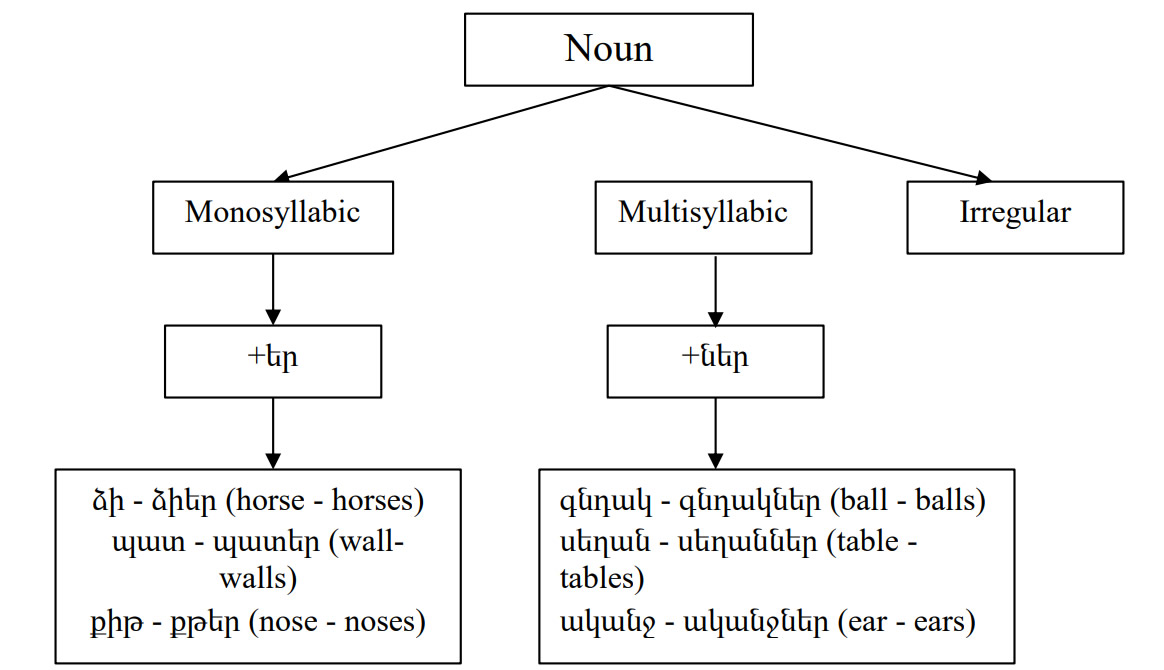Difference between revisions of "Language/Armenian/Grammar/Plurals"
| Line 2: | Line 2: | ||
[[File:Armenian-Language-Polyglotclub.png|thumb]] | [[File:Armenian-Language-Polyglotclub.png|thumb]] | ||
We have already used a few words in the plural, but so far we have worked mostly with singular nouns. Let us study the formation of plurals. The great majority of nouns form their plural by adding -ներ if the word is multi-syllabic, and -եր if they are monosyllabic. The chart below summarizes the formation of plurals. | In this lesson, we will learn about the formation of plurals in Armenian. | ||
We have already used a few words in the plural, but so far we have worked mostly with singular nouns. Let us study the formation of plurals. The great majority of nouns form their plural by adding -ներ if the word is multi-syllabic, and -եր if they are monosyllabic. | |||
== Summary == | |||
The chart below summarizes the formation of plurals. | |||
[[File:Armenian-Language- Plurals PolyglotClub.jpg]] | [[File:Armenian-Language- Plurals PolyglotClub.jpg]] | ||
== Adding -ներ for Multi-Syllabic Words == | |||
For the majority of multi-syllabic nouns, the plural is formed by adding -ներ to the end of the word. Here are some examples: | |||
* գործ (work) → գործներ (works) | |||
* մանրածառ (detailed) → մանրածառներ (details) | |||
* կապ (relationship) → կապներ (relationships) | |||
== Adding -եր for Monosyllabic Words == | |||
For monosyllabic nouns, the plural is formed by adding -եր to the end of the word. Here are some examples: | |||
* անուն (name) → անուններ (names) | |||
* բարեկամ (friend) → բարեկամեր (friends) | |||
* գին (price) → գիներ (prices) | |||
== Plural Formation for Words Ending in a Vowel == | |||
For words ending in a vowel, the plural is formed by adding -ներ to the end of the word. Here are some examples: | |||
* այբբեն (language) → այբբեններ (languages) | |||
* հոգեբանություն (psychology) → հոգեբանություններ (psychologies) | |||
* ծով (sea) → ծովներ (seas) | |||
== Irregular Plural Formation == | |||
Some words have irregular plural forms that do not follow the rules mentioned above. Here are some examples: | |||
* կենդանական (animal) → կենդանիներ (animals) | |||
* մարդ (man/person) → մարդիկ (people) | |||
There are a few irregular plurals, which are listed below: | There are a few irregular plurals, which are listed below: | ||
Revision as of 16:04, 3 March 2023
In this lesson, we will learn about the formation of plurals in Armenian.
We have already used a few words in the plural, but so far we have worked mostly with singular nouns. Let us study the formation of plurals. The great majority of nouns form their plural by adding -ներ if the word is multi-syllabic, and -եր if they are monosyllabic.
Summary
The chart below summarizes the formation of plurals.
Adding -ներ for Multi-Syllabic Words
For the majority of multi-syllabic nouns, the plural is formed by adding -ներ to the end of the word. Here are some examples:
- գործ (work) → գործներ (works)
- մանրածառ (detailed) → մանրածառներ (details)
- կապ (relationship) → կապներ (relationships)
Adding -եր for Monosyllabic Words
For monosyllabic nouns, the plural is formed by adding -եր to the end of the word. Here are some examples:
- անուն (name) → անուններ (names)
- բարեկամ (friend) → բարեկամեր (friends)
- գին (price) → գիներ (prices)
Plural Formation for Words Ending in a Vowel
For words ending in a vowel, the plural is formed by adding -ներ to the end of the word. Here are some examples:
- այբբեն (language) → այբբեններ (languages)
- հոգեբանություն (psychology) → հոգեբանություններ (psychologies)
- ծով (sea) → ծովներ (seas)
Irregular Plural Formation
Some words have irregular plural forms that do not follow the rules mentioned above. Here are some examples:
- կենդանական (animal) → կենդանիներ (animals)
- մարդ (man/person) → մարդիկ (people)
There are a few irregular plurals, which are listed below:
| Noun in English | Noun in Armenian | Plural in Armenian |
|---|---|---|
| human being | մարդ | մարդիկ |
| man | տղամարդ | տղամարդիկ |
| woman/wife | կին | կանայք |
| sheep | գառ | գառներ |
| bride | հարս | հարսներ |
| finger | մատ | մատներ |
Examples
For example:
- Հարսը գեղեցիկ է։ The bride is beautiful.
- Հարսները գեղեցիկ են։ The brides are beautiful.
- Կինը տալիս է տանձ։ The woman gives a pear.
- Կանայք տալիս են տանձեր։ The women give pears.
Sources
https://slaviccenters.duke.edu/sites/slaviccenters.duke.edu/files/handbook_of_armenian.pdf

